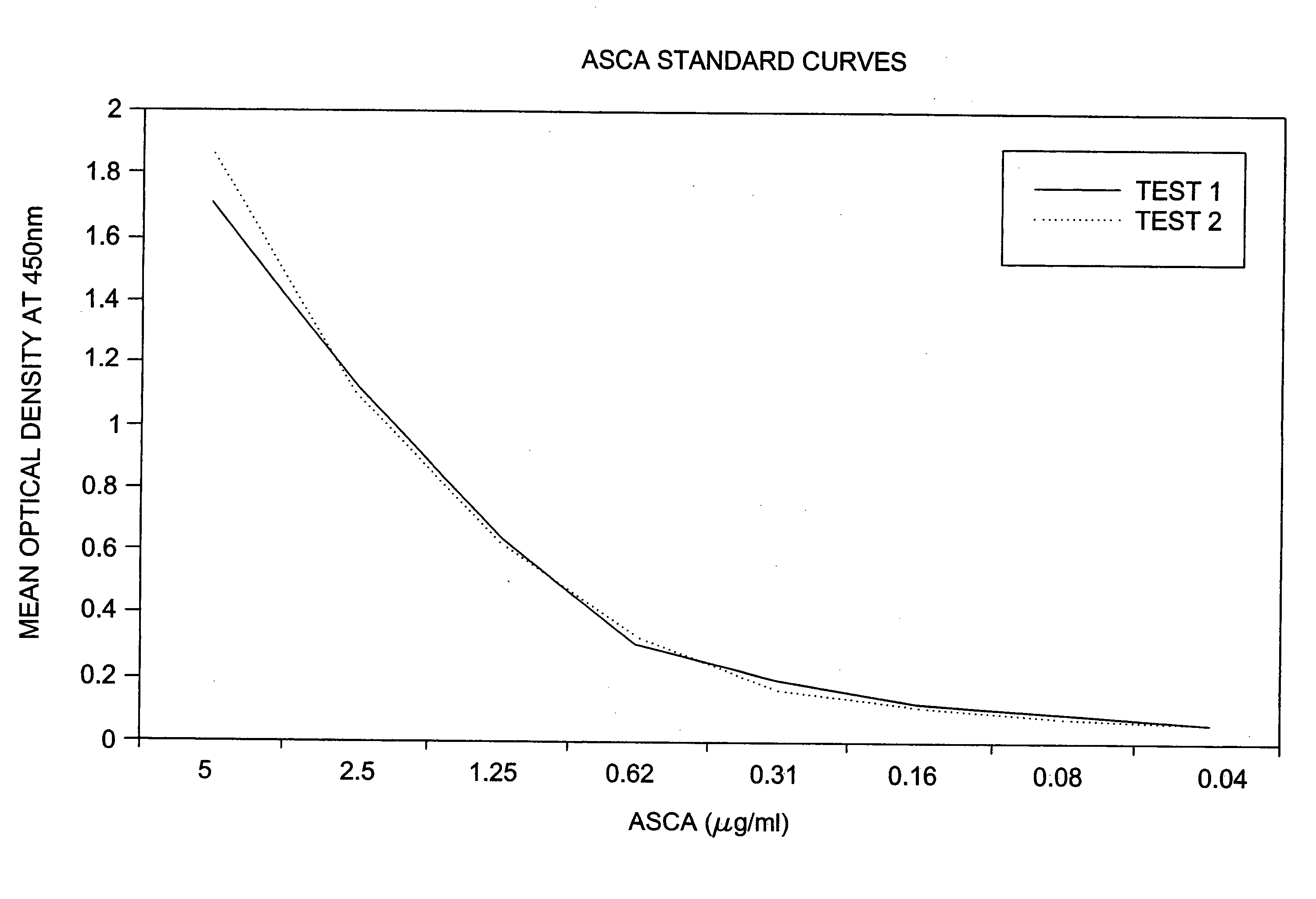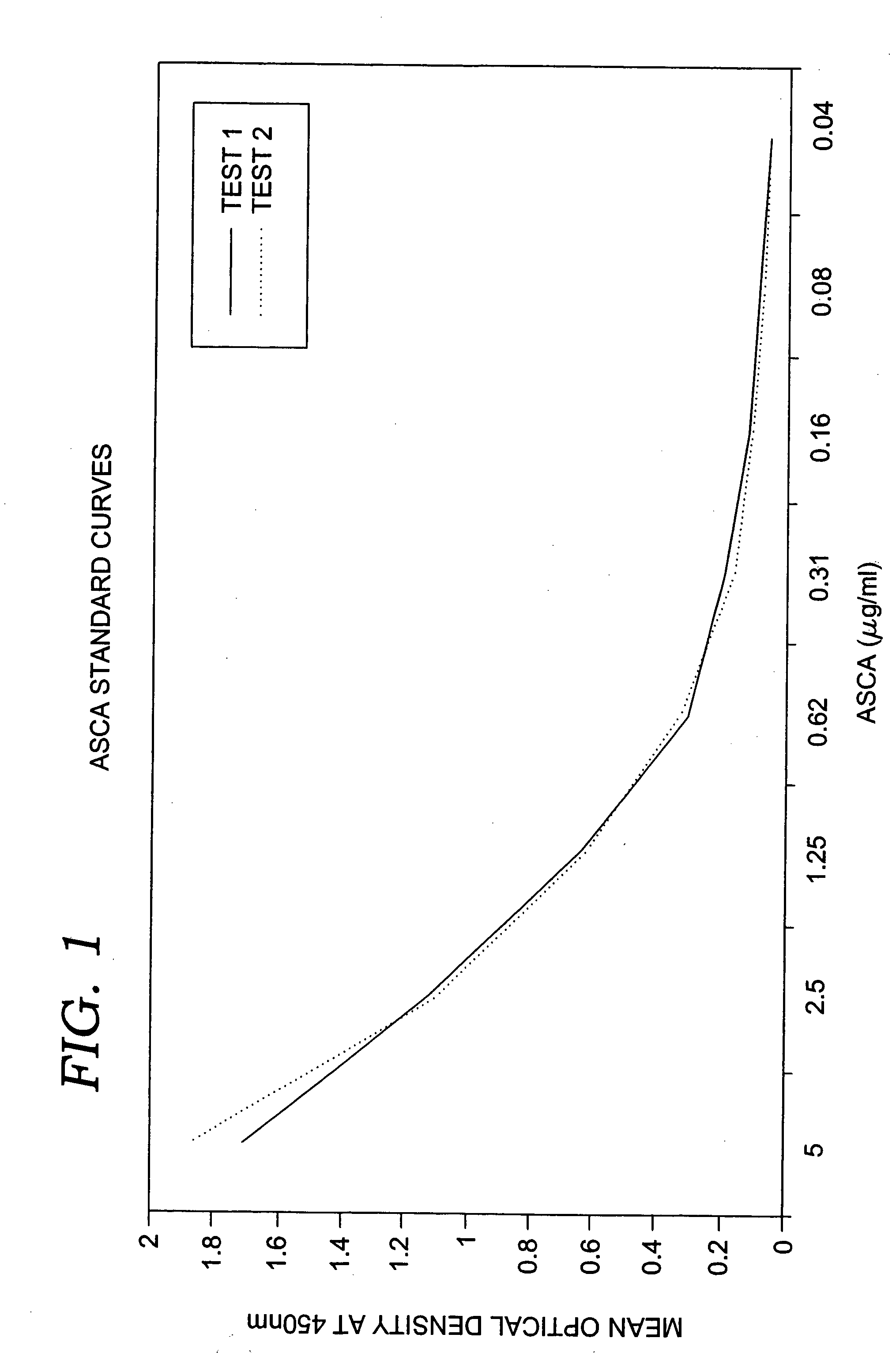Method and apparatus for distinguishing Crohn's disease from ulcerative colitis and other gastrointestinal diseases by detecting the presence of fecal antibodies to Saccharomyces cerevisiae
a technology of saccharomyces cerevisiae and fecal antibodies, which is applied in the field of method and apparatus for the differentiation of crohn's disease from other gastrointestinal illnesses, can solve the problems of not being able to achieve rapid differential diagnosis and serum antibodies may not be accurate indicators of proper diagnosis
- Summary
- Abstract
- Description
- Claims
- Application Information
AI Technical Summary
Benefits of technology
Problems solved by technology
Method used
Image
Examples
example 1
[0020] In this example using an ELISA method, a fecal sample was obtained and serially diluted 20 fold. 100 μl of the diluted sample was added to a test well of a microassay plate coated with extract of Saccharomyces cerevisiae and purified mannan. The sample then was incubated at 37° C. to allow antibodies to Saccharomyces cerevisiae to bind to the extract of Saccharomyces cerevisiae. Following incubation, anti-human Ig polyclonal antibodies coupled to horseradish peroxidase enzyme (conjugate) were added to the test well and allowed to bind to captured ASCA. Unbound conjugate then was washed from the well and one component substrate (tetra-methyl-benzidene and hydrogen peroxide) was added for color development. Following the substrate incubation, 0.1M sulfuric acid was added to quench the reaction and the optical density (OD) was obtained spectrophotometrically at 450 nm using a single wavelength spectrophotometer.
[0021] The method described above was used in a clinical study to t...
example 2
[0030] In this example, the sensitivity of the fecal ASCA test was determined using serial two fold dilutions of highly purified ASCA antibodies. For the analysis, standard curves were generated using the kit dilutent. The test was consistently positive at a concentration of 0.62 μg / mL as determined by a cutoff absorbency value of ≧0.200. Individual results are shown below in Table 10. The standard curves are shown in FIG. 1.
TABLE 10Standard curves generated using purified ASCA antibodiesPurifiedASCAAntibodies(μg / mL)Test 1Test 2MeanStd Dev5.001.7021.8561.7790.1082.501.1171.0991.1080.0121.250.6340.6240.6290.0070.620.3030.3290.3160.0180.310.1910.1640.1770.0190.160.1150.1130.1140.0010.080.0900.0770.0830.0090.040.0630.0650.0640.001
example 3
[0031] In this example, tests were conducted to determine what type of immunoglobulins (antibodies) were present in a fecal sample and in serum. The immunglobulin typing was done for human IgA, human IgAsec, human IgD, human IgM, and human IgG. The immunoglobulin typing was done on a fecal sample from 6 Crohn's disease patients and 2 ulcerative colitis and on a serum control sample using pre-absorbed Ig-type specific conjugates. The serum control sample was obtained from a patient with a confirmed allergy to Saccharomyces cerevisiae.
[0032] Of the Crohn's disease patients, 5 patients exhibited a response to IgA and IgAsec, 4 patients exhibited a response to IgM and a single patient exhibited a response to IgG. Of the 2 ulcerative colitis patients, a single patient reacted with the Ig conjugate. The serum control only exhibited a response to individual immunoglobulins IgM and IgG. A response to IgA and IgAsec occurred the fecal samples but not in the control serum sample. A summary o...
PUM
| Property | Measurement | Unit |
|---|---|---|
| single wavelength spectrophotometer | aaaaa | aaaaa |
| optical density | aaaaa | aaaaa |
| optical density | aaaaa | aaaaa |
Abstract
Description
Claims
Application Information
 Login to View More
Login to View More - R&D
- Intellectual Property
- Life Sciences
- Materials
- Tech Scout
- Unparalleled Data Quality
- Higher Quality Content
- 60% Fewer Hallucinations
Browse by: Latest US Patents, China's latest patents, Technical Efficacy Thesaurus, Application Domain, Technology Topic, Popular Technical Reports.
© 2025 PatSnap. All rights reserved.Legal|Privacy policy|Modern Slavery Act Transparency Statement|Sitemap|About US| Contact US: help@patsnap.com


